Last Updated on January 25, 2024 by Greg Gillson
Did you see a brightly colored red bird, orange bird, or yellow bird in North Dakota and wonder what it was?
This page is for you!
This article shows you photos and identification of some of the most common birds in North Dakota based on the colors red, orange, and yellow.
The list of birds found in North Dakota includes over 405 species. So, I can’t show you all of them. I’m going to assume that you saw a common bird of this color, but you certainly could have seen something less common, or even rare!
Shape (including the shape of the bill) and size are often more helpful in starting to identify a bird than the color. In fact, most birds in North American can be easily identified with a black-and-white photo!
Many birds are multi-colored, so that it may be hard to pick out a dominant color. Males and females may be colored quite differently. And some color patterns are similar among otherwise dissimilar species.
Nevertheless, I’m going to try to pick out some of the birds that you are most likely to see in backyards or towns. And I’ll show a few others that I get asked about a lot.
The birds with a noticeable amount of red on them in North Dakota covered in this article are:
- American Robin
- House Finch
- Common Redpoll
- Purple Finch
The birds with a noticeable amount of orange on them in North Dakota covered in this article are:
- Barn Swallow
- Ruddy Duck
- Red-breasted Nuthatch
- Baltimore Oriole
- Brown Thrasher
- American Redstart
- Orchard Oriole
- Spotted Towhee
- American Kestrel
- Cooper’s Hawk
The birds with a noticeable amount of yellow on them, including lots of yellow and black birds, in North Dakota covered in this article are:
- American Goldfinch
- Western Meadowlark
- Yellow Warbler
- Northern Flicker
- Cedar Waxwing
- Yellow-headed Blackbird
- Common Yellowthroat
- Western Kingbird
- Pine Siskin
- Yellow-rumped Warbler
- Yellow-breasted Chat
- Great Crested Flycatcher
Red birds of North Dakota
Birds get the red, orange, and yellow in their feathers from carotenoids in the fruit, seeds, and plants they eat (source).
These carotenoid colors combine with melanin to form an infinite range of red feathers–pink, rusty, scarlet, violet, red-orange.
The following are red birds that you are most likely to see in North Dakota.
American Robin
These are familiar lawn birds with red breasts.
 |
| American Robin. Greg Gillson. |
Male American Robins are brownish-gray above with a brick red breast. Females are paler orange below and paler gray above.
They are widespread in open country with scattered deciduous trees, residential areas.
American Robins are summer residents throughout North Dakota, year-round residents in extreme southeastern and southwestern North Dakota.
House Finch
When people ask about a bird with a red head at their feeder, it is usually this bird.
 |
| Male House Finch. Greg Gillson. |
Males of this dusty brown striped finch have red limited to the head (specifically the forehead and eyebrow), breast (chest), and rump. The red coloration tends toward orangish and may rarely be yellowish.
Females are streaked, similar to the males but without red. They lack any strong pattern on the face and head.
Note the small round head and curved upper ridge on the bill.
Some people call these red-headed sparrows. Sparrows and finches are similar, but in general, male finches are brighter than the females and tend to hang out more in trees. Sparrow genders are usually quite similar in coloration and tend to feed mostly on the ground.
These birds are common in residential areas, especially at bird feeders. In the West more widespread in arid regions near water.
House Finches are year-round residents throughout North Dakota.
Common Redpoll
These frosty pink and red birds are northern relatives of the goldfinches.
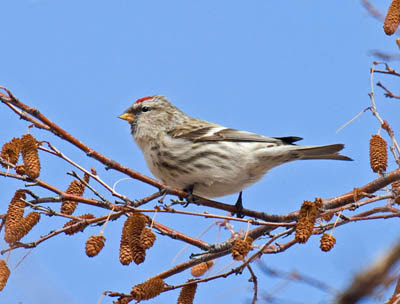 |
| Common Redpoll. Greg Gillson. |
These birds are frosty white in winter with brown striping above and on the sides. Both genders have red caps, black around bill and chin. Adult males have red upper breast. Immatures less red.
These birds are found in weedy fields and alder and birch trees in winter. Come to thistle feeders.
Common Redpolls are regular winter visitors in northern and northeastern North Dakota, less common winter visitors throughout North Dakota.
Purple Finch
Forest finches of the foothills, delicately frosted in pinkish-red.
 |
| Male Purple Finch. Greg Gillson. |
Told from more common House Finch by bigger square or peaked head, bigger bill, lacks sharp striping below, deeply notched tail. Red covers all plumage.
Females lack red color, shows strongly patterned dark ear patch outlined all around with a pale stripe, is heavily streaked below.
Found in foothills and damp mountains conifers and mixed woods. Visit feeders, but less frequently than House Finches.
Purple Finches are winter visitors throughout North Dakota.
Orange birds of North Dakota
True orange-colored birds are not that common. Many birds that I have here are paler rusty.
The common pattern is an orange body and black or brown wings and tail. Another common pattern is for the orange to be restricted to the under parts.
The following are orange birds that you are most likely to see in North Dakota.
Barn Swallow
These orange-bellied birds are a familiar sight across North America in summer.
 |
| Barn Swallow. Greg Gillson. |
These birds are purple-blue above with orange under parts and long forked tails. The color of the underparts in winter or on females are often cinnamon or buff-colored, but breeding males can be brighter orange-red.
These birds swoop low over fields and wetlands at lower elevations. They may build their mud nests in rafters on porches, garages, or other out-buildings.
Barn Swallows are summer residents throughout North Dakota
Ruddy Duck
These small ducks are dark rusty-orange in spring.
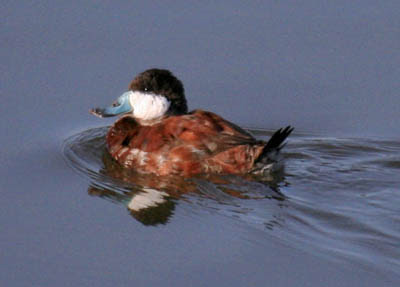 |
| Ruddy Duck. Greg Gillson. |
Males in breeding plumage (late winter and spring) are rusty, with a white face, and a blue bill. The long tail is often held sticking up. In winter they are brown, with white face, and dark bill.
Females all year are like winter males. Brown body, dark cap, dark line through eye of pale face. Dark bill.
These birds prefer weedy ponds to breed, but in winter may be found in deeper ponds in city parks.
Ruddy Ducks are summer residents throughout North Dakota.
Red-breasted Nuthatch
These active little red-breasted birds crawls all around on the trunk and big branches of conifers. They search crevices in the bark for insect food.
 |
| Red-breasted Nuthatch. Greg Gillson. |
These tiny birds have blue-gray backs and a black line through a white face. Some males can have quite bright rusty red under parts. Some females can have quite pale buff-colored under parts. Most birds show an orange-cinnamon breast color.
Found nearly exclusively in conifers. Readily come to feeders.
Red-breasted Nuthatches are winter visitors throughout North Dakota.
Baltimore Oriole
These bright orange and black birds are fairly common breeders in wooded areas in the East.
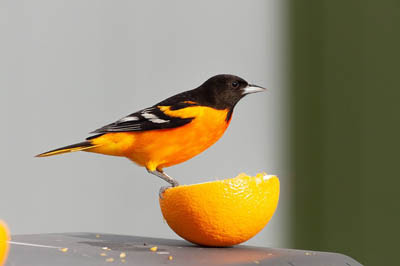 |
| Baltimore Oriole. Michael McGough. Pixabay. |
Males have a black hood and back. Wings black with white patches. Tail black with orange sides to the base. Bright orange under parts.
Females are similar to males, but more olive above, less black. Immature birds for their first year or more are olive above orangish-yellow on the breast, fading to yellow on the belly. Two white wing bars.
These birds are common in deciduous woods, shade trees.
Baltimore Orioles are summer residents throughout North Dakota.
Brown Thrasher
These are rather large rusty-orange songbirds.
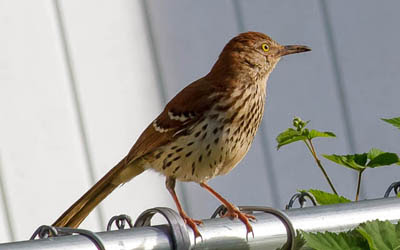 |
| Brown Thrasher. Linda Jones CC0. |
The upper parts of these birds are colored rusty-brown to orange. They show two white wing bars. Under parts are buff with heavy reddish-brown streaking.
These birds live in woodland edges and mature backyard landscaping.
Brown Thrashers are summer residents throughout North Dakota.
American Redstart
In flight these small warblers flash orange or yellow in the wing and base of the tail.
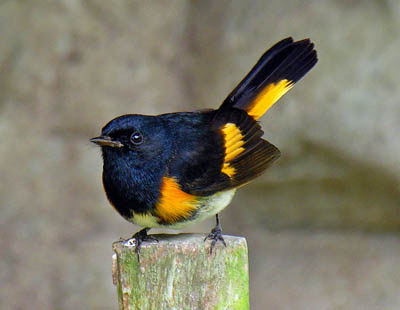 |
| American Redstart. Dennis Jarvis. Flikr. CC BY-SA 2.0 |
Males are black above, white on the belly. They have bright orange patches on side of breast, wings, and base of the tail.
Females are grayer, especially on the head. The orange of males is replaced by yellow on the females.
These birds are found in regenerating woods after a clear cut, and willow tangles along streams.
American Redstarts are summer residents scattered about northeastern and western North Dakota, as well as limited in south-central North Dakota.
Orchard Oriole
Males of these orioles are darker rustier orange than most other orioles in the United States.
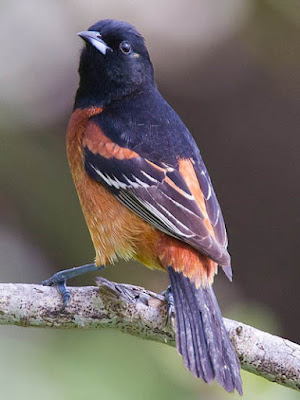 |
| Orchard Oriole. Dan Pancamo. Flikr. CC BY-SA 2.0 |
Males have a black hood and back, black wings and tail. The under parts are rusty-orange or even chestnut-brown.
Females are greenish above, lemon yellow below. They have 2 thin white wing bars. The bill is thinner than many other orioles.
They are found in orchards and residential shade trees.
Orchard Orioles are summer residents throughout most of North Dakota, absent in parts of northeastern and northwestern North Dakota.
Spotted Towhee
These big sparrows with red sides superficially resemble the coloration of robins.
 |
| Spotted Towhee. Greg Gillson. |
These birds have dark hoods and upper parts with rusty rufous-red sides and white bellies. They have white spots over their wings, shoulders, and on their tail corners. The upper parts of the males are jet black, females dark brown. Some populations have paler orange sides.
These are somewhat shy birds that hide in the dense brush and spend most of their time on the ground. They visit feeders during quiet periods.
Spotted Towhees are summer residents in western North Dakota.
American Kestrel
These are the familiar small rusty-orange falcons sitting on power lines on the edge of the highway or hunting and hovering over the median strip.
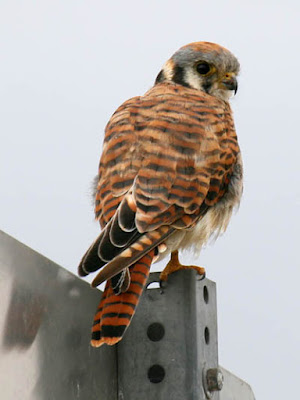 |
| Female American Kestrel. Greg Gillson. |
Females are rusty orange barred with black on their back wings and tail. The under parts are buff with black spots. The head shows two facial stripes.
Males have blue-gray backs and rufous tail is unmarked except for black tail band.
These birds are found in open country, farms, pastures with perches.
American Kestrels are summer residents throughout North Dakota.
Cooper’s Hawk
These crow-sized hawks with reddish orange bars on the under parts may show up in fall or winter to hunt birds at your feeder. Oh no!
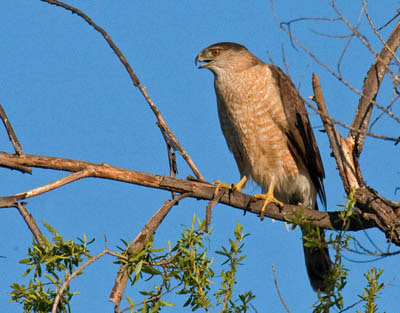 |
| Cooper’s Hawk. Greg Gillson. |
Adults with long gray and black banded tail. Dark gray above and cap on head. Under parts barred with rusty orange.
Immatures similar, brownish, streaked with brown on under parts.
Found in forests and woodlands, residential shade trees.
Cooper’s Hawks are summer residents throughout most of North Dakota, absent in extreme northwestern North Dakota.
Yellow birds of North Dakota
Yellow is a common bird color! Often it is mixed with black and white plumage in birds.
Many birds with darker upper parts have yellow breast or belly.
The following are yellow birds you are most likely to see in North Dakota.
American Goldfinch
These small little birds are bright yellow and black.
 |
| American Goldfinch. Greg Gillson. |
Males are bright lemon yellow with black and white wings and tail, black cap. White under tail coverts. Pink bill.
Females are duller yellow below and brownish above. Lack black cap.
Winter birds are pale brown or gray, a touch of yellow on the throat of males.
These are birds of open country, fields with saplings, clear cuts, residential areas. They avoid dense forests, mountains, deserts. They visit feeders.
American Goldfinches are summer residents throughout North Dakota.
Western Meadowlark
These are streaky camouflaged prairie birds from above or from behind. But from the front, the breast is shocking yellow!
 |
| Western Meadowlark. Greg Gillson. |
They are streaked brown, black, and gray on the upper parts. The underparts are golden yellow with a black necklace crossing the upper breast. Much paler yellow in fall and winter, as the yellow feathers are tipped with white and streaked with brown.
These are birds of pastures and grasslands and arid regions.
Western Meadowlarks are summer residents throughout North Dakota.
Yellow Warbler
The golden yellow sun packed all into one little bird! Appears to be an all-yellow bird.
 |
| Yellow Warbler. Greg Gillson. |
Some populations are bright yellow, some tend toward greenish on upper parts, some more golden. Yellow internal tail corners in flight.
Males with red breast streaking, again, variable by population.
Females somewhat to much paler yellow, some greenish, some whitish. Lack red streaks.
These birds are found in willow thickets on the edge of wetlands and ditches, stream sides in arid regions.
Yellow Warblers are summer residents throughout North Dakota.
Northern Flicker
These woodpeckers spend much time eating ants on the ground.
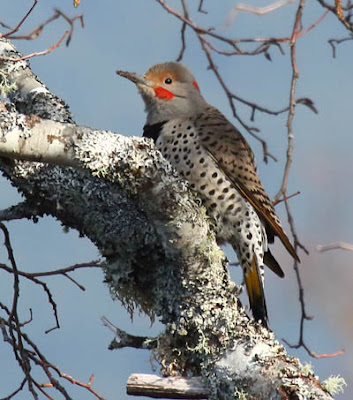 |
| Northern Flicker. Greg Gillson. |
These birds are larger than robins with brown and black barred upper parts. The underparts are pink with round black spots. There is a black crescent across the chest. When they fly away from you, they reveal a large white rump.
Western birds have salmon-red under wings and under tail. Those in the East are colored yellow. The male face differs between the two populations–black whisker on the eastern birds, red whisker on western birds. Intergrades from overlap on Great Plains common. These may show male facial characteristics of both populations, or yellow-orange flight feathers.
These birds live in open woods with bare ground for foraging, residential yards.
Northern Flickers are year-round residents throughout North Dakota.
Cedar Waxwing
These crested birds with yellow band on the end of the tail are often found in flocks. They eat flying insects in summer, fruit and berries the rest of the year.
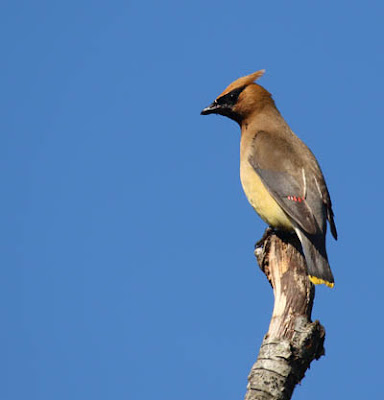 |
| Cedar Waxwing. Greg Gillson. |
These birds are fawn-brown above, with dark gray wings and tail. They have a black mask and wispy crest. The belly is yellow. The wings have waxy red drops on the end of the tertials. The end of the tail has a brilliant yellow tail band.
They are found in open habitats with berries, including juniper woodlands and towns in winter.
Cedar Waxwings are year-round residents throughout North Dakota.
Yellow-headed Blackbird
These blackbirds with yellow heads are found in marshes in the West.
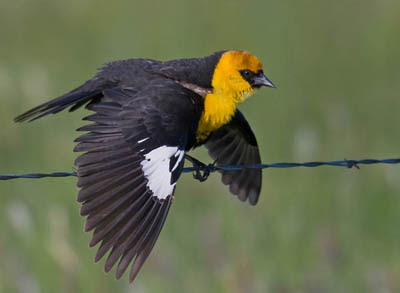 |
| Yellow-headed Blackbird. Greg Gillson. |
Males are glossy black with bright golden-yellow head and breast. White wing patches.
Females are duller brown with mottled yellow breast.
These birds nest in cattail marshes in prairies. Winter in large flocks in agricultural areas.
Yellow-headed Blackbirds are summer residents throughout North Dakota.
Common Yellowthroat
These buttery yellow birds are abundant in the marsh vegetation.
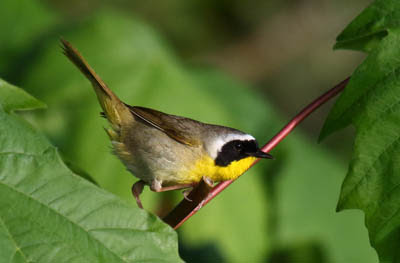 |
| Male Common Yellowthroat. Greg Gillson. |
These skulkers have bright yellow throats and yellow undertail coverts. Males have a black domino mask edged broadly in white, which females lack. Upperparts are dull olive-green.
Immature males in fall show a shadowed black mask.
Found in damp situations and heavy deciduous brambles following clear cuts.
Common Yellowthroats are summer residents throughout North Dakota.
Western Kingbird
These yellow-bellied birds of the prairies often perch on power lines and fence lines.
 |
| Western Kingbird. Greg Gillson. |
These birds are pale gray on the head and breast. Brown wings. The belly is lemon yellow. Black tail has white outer tail feathers, especially obvious in flight.
These are birds of prairies, deserts, pastures, often near water.
Western Kingbirds are summer residents throughout North Dakota.
Pine Siskin
These small brown-streaked birds are relatives of the goldfinches. But you would never know it until they fly and sport yellow wing stripes and tail base. Usually in flocks.
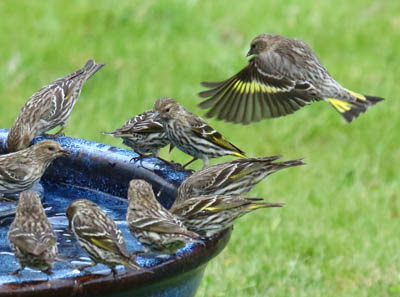 |
| Pine Siskin. Greg Gillson. |
These birds are streaked brown. In flight they have a yellow stripe down the length of the wing. The sides of the base of the tail are also yellow. Some birds are paler, some darker, others brighter yellow, others duller.
These birds are found in summer in northern conifer woods. Irregularly irrupt hundreds of miles southward. Frequent at feeders.
Pine Siskins are winter visitors throughout North Dakota.
Yellow-rumped Warbler
These are abundant warblers across North America. Affectionately called “butter butts” by many birders, because of their bright yellow rumps that flash in flight.
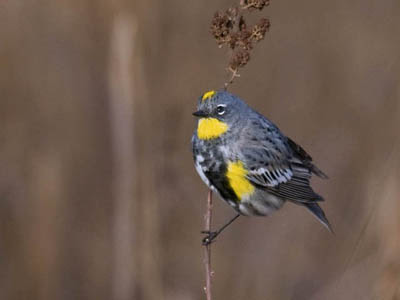 |
| Male Audubon’s Yellow-rumped Warbler. Greg Gillson. |
Western form (Audubon’s) with bright yellow throat and yellow rump. Large white wing patch.
Northern and Eastern form (Myrtle) with white throat, yellow rump, and two white wing bars.
Winter birds are dull gray-brown, with bright yellow rump. Throat may be cream colored or white. Often difficult to tell the two forms apart in winter.
 |
| Winter Yellow-rumped Warbler. Greg Gillson. |
Breed in mountain or boreal conifers. Widespread in migration. Winter in low river bottoms, open weedy deciduous areas. Rarely come to feeders in winter.
Yellow-rumped Warblers are spring and fall migrants only throughout North Dakota.
Yellow-breasted Chat
These unique larger yellow birds may sing day and night, and include whistles and crow-like cawing, often given in a display flight.
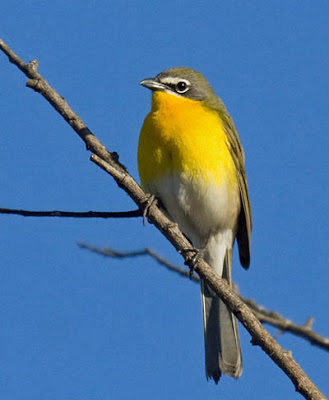 |
| Yellow-breasted Chat. Greg Gillson. |
These birds are greenish above with bright yellow breast and white belly. They have a dark mask bordered with white.
These birds live in tangles and wet woods.
Yellow-breasted Chats are summer residents in western and southwestern North Dakota.
Great Crested Flycatcher
These flycatchers have long tails and big heads with big bill and bright yellow belly.
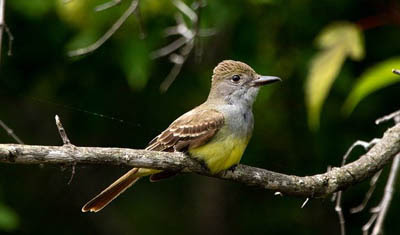 |
| Great Crested Flycatcher. Simard Francois. Pixabay. |
These birds are gray on the face and breast, brownish on rest of upper parts. Bright lemon-yellow belly. The under sides of the tail and some feathers of the wing are cinnamon colored.
These birds stay in the canopy of open woods.
Great Crested Flycatchers are summer residents in northeastern North Dakota.
Wrapping Up
North Dakota boasts a variety of beautiful colored birds but there are also many attractive black and white ones, each with their own unique charm and characteristics. Here are some of the most notable ones:
- Black-capped Chickadee: Arguably the most recognizable, this charismatic songbird sports a black cap, bib, and back contrasted with its white cheeks and body. Their cheerful “chick-a-dee” call brightens winter landscapes.
- Downy Woodpecker: These small woodpeckers are frequent backyard visitors, easily identified by their black and white markings, pointed beak, and habit of drumming on trees.
- Dark-eyed Junco: These ground-feeding birds are common during winter months, with their slate-gray upperparts, white bellies, and distinctive pink beaks. Look for them foraging in flocks under trees and shrubs.
- Snow Bunting: These winter visitors grace snowy fields with their striking black and white plumage, white wingbars, and bright pink beaks. Their song is a sweet, musical trill.
- Common Loon: While they primarily spend time on water, loons may be spotted on land during migration. Their black and white plumage, yellow bill, and loud yodeling call make them unmistakable.
- Black-billed Magpie: These intelligent birds are known for their long, black and white tails and loud, chattering calls. Look for them in open areas like farms and grasslands.
Frequently Asked Questions
Are there cardinal birds in North Dakota?
Yes, there are Northern Cardinals in North Dakota! However, their presence in the state is a bit more complex than with many other bird species. Here’s the breakdown:
Historical Presence:
- Prior to the 20th century, Northern Cardinals were primarily found in the eastern and southern United States, not reaching North Dakota.
- Habitat changes, like increased forest cover due to fire suppression, created suitable habitat for cardinals to expand their range northward.
Current Status:
- While not as abundant as in some other states, Northern Cardinals are now established in parts of North Dakota, especially in the eastern and southern regions.
- They’re most commonly found in river valleys, wooded edges, and areas with brushy undergrowth, where they find food and shelter.
- Sightings and breeding records of cardinals in North Dakota have become more frequent in recent years, indicating a gradual increase in their population.

What is the yellow breasted bird in North Dakota?
Determining the yellow-breasted bird you saw in North Dakota depends on several factors, like the time of year and the specific location. Here are some strong contenders to consider:
Summer Residents:
- American Goldfinch: The most likely candidate, especially between late spring and early fall. These vibrant songbirds have a bright yellow body with black wings and cap, making them easily recognizable. Look for them in fields, meadows, and open woodlands.
- Common Yellowthroat: Smaller than a goldfinch with a distinctive black mask across its face and a bright yellow throat. They favor moist areas like marshes and wet meadows.
Migratory Visitors:
- Yellow Warbler: These warblers arrive in North Dakota during spring and summer, sporting a bright yellow body with streaked wings and a white throat. They prefer wooded areas and edges.
- Palm Warbler: Another yellow warbler found in the state during migration, primarily in April and May. They have a yellow body with streaked wings and a yellow rump. Look for them in open woodlands and coniferous forests.
Related Articles:
See photos and learn about the most common backyard birds in North Dakota, regardless of color.
Here’s a quick tutorial of how I would teach you to identify birds: 7 Steps to Identify Birds!
Birds with red heads in North America.
Yellow-and-black birds in North America.









